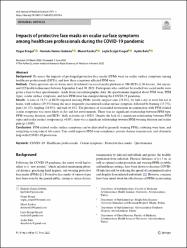Impacts of protective face masks on ocular surface symptoms among healthcare professionals during the COVID-19 pandemic

View/
Access
info:eu-repo/semantics/embargoedAccessDate
13.06.2022Metadata
Show full item recordAbstract
Background
To assess the impacts of prolonged protective face masks (PFM) wear on ocular surface symptoms among healthcare professionals (HCPs), and how these symptoms affected PFM wear.
Methods
Thirty-question survey forms were distributed via social media platform to 396 HCPs (110 doctors, 164 nurses, and 122 health technicians) between September 8 and 30, 2021. Participants who could not be reached via social media were given a face-to-face questionnaire. Aside from sociodemographic data, the questionnaire inquired about PFM wear, PFM types, ocular surface symptoms, and how PFM wear has changed during the COVID-19 pandemic.
Results
A total of 74.5% of HCPs reported wearing PFMs, mostly surgical ones (76.8%), for half a day at work but not at home, with redness (29.3%) being the most frequently encountered ocular surface symptom, followed by burning (15.7%), pain (14.1%), tingling (10.9%), and rash (6.6%). The presence of associated restrictions in conjunction with PFM-related ocular symptoms was more likely in dry and hot environments. There was no significant relationship between PFM type, PFM-wearing duration, and HCPs’ daily activities (p > 0.05). Despite the lack of a significant relationship between PFM types and ocular surface symptoms (p > 0.05), there was a significant relationship between PFM-wearing duration and ocular pain (p < 0.05).
Conclusions
PFM-related ocular surface symptoms can be alleviated by properly wearing PFMs, reducing wear time, and using long-acting topical lubricants. This could improve PFM wear compliance, prevent disease transmission, and ultimately help with COVID-19 protection.















